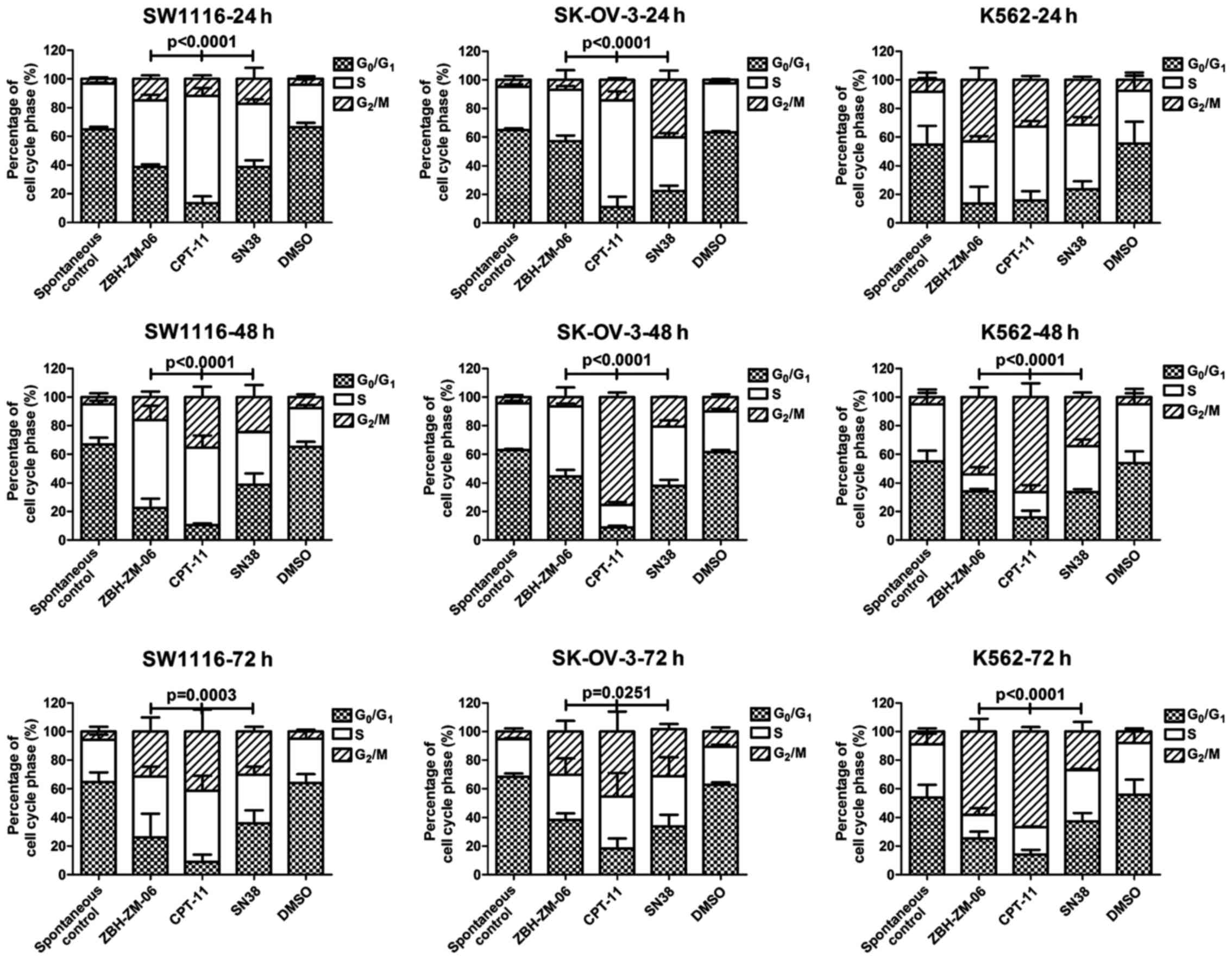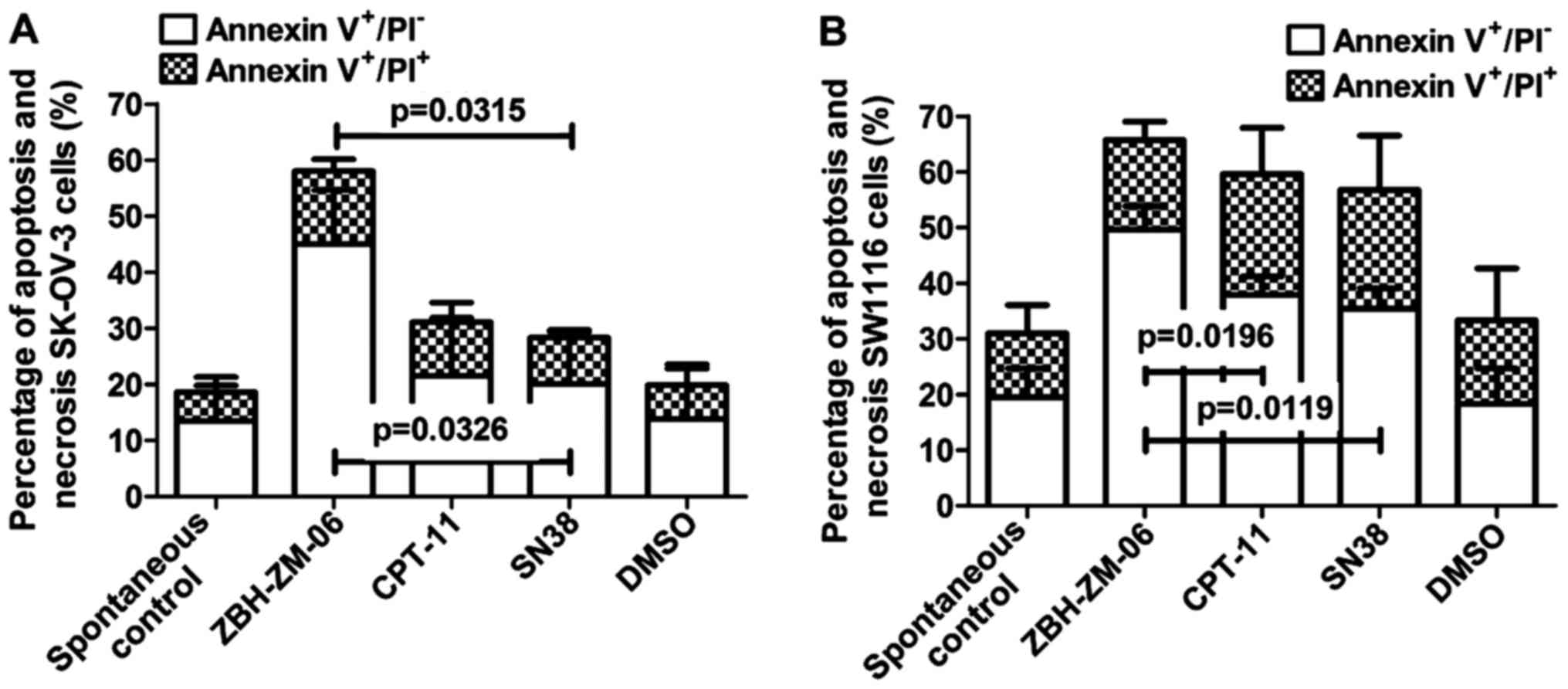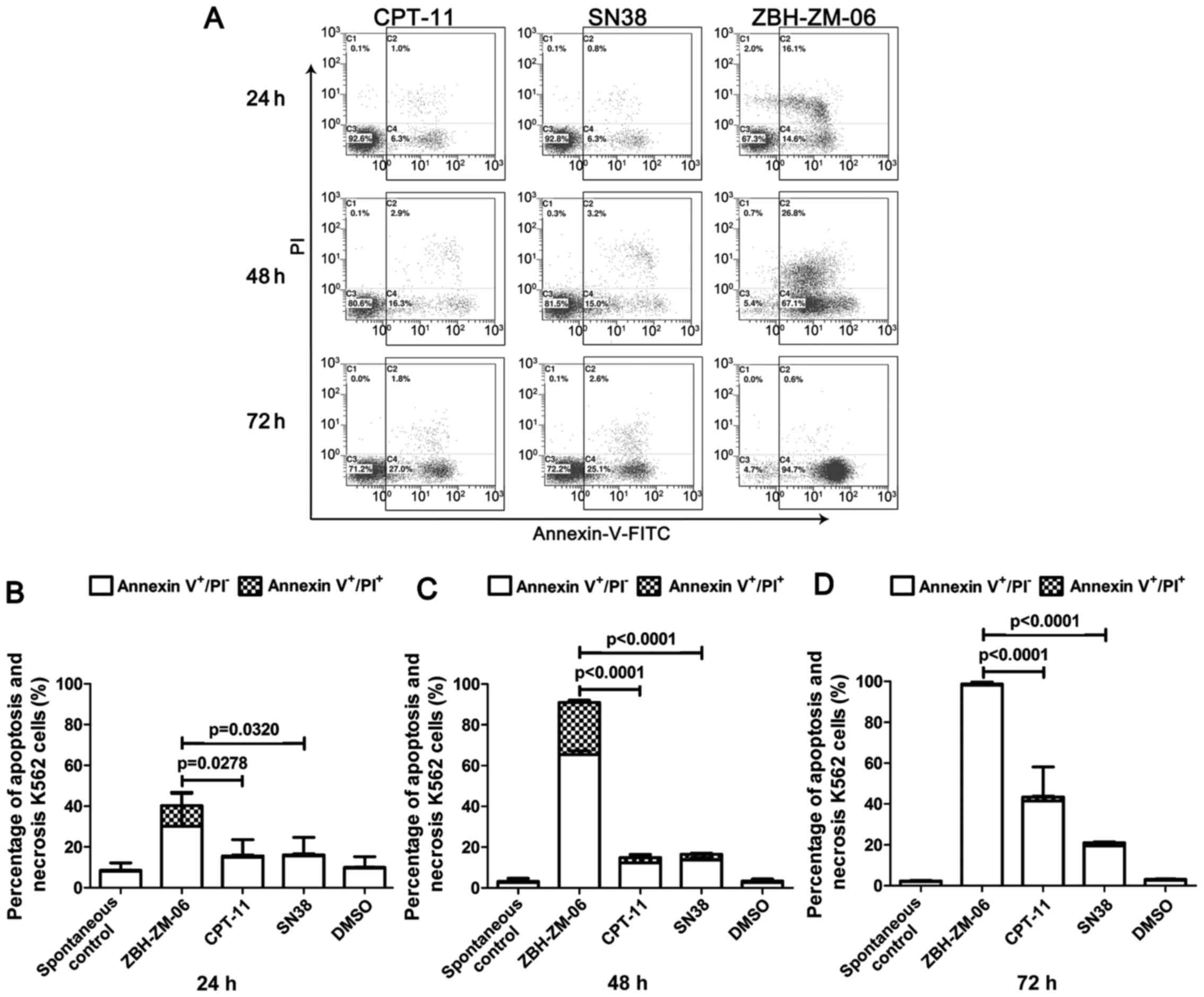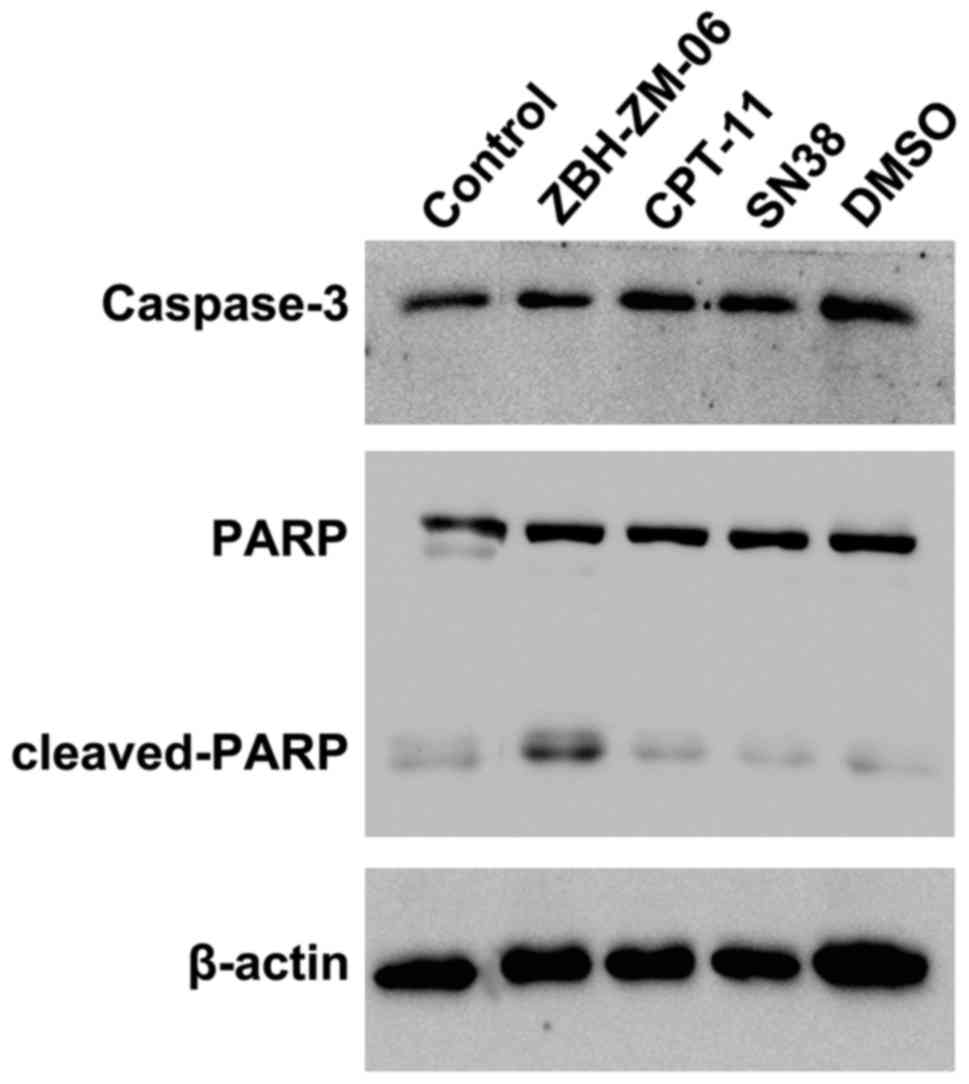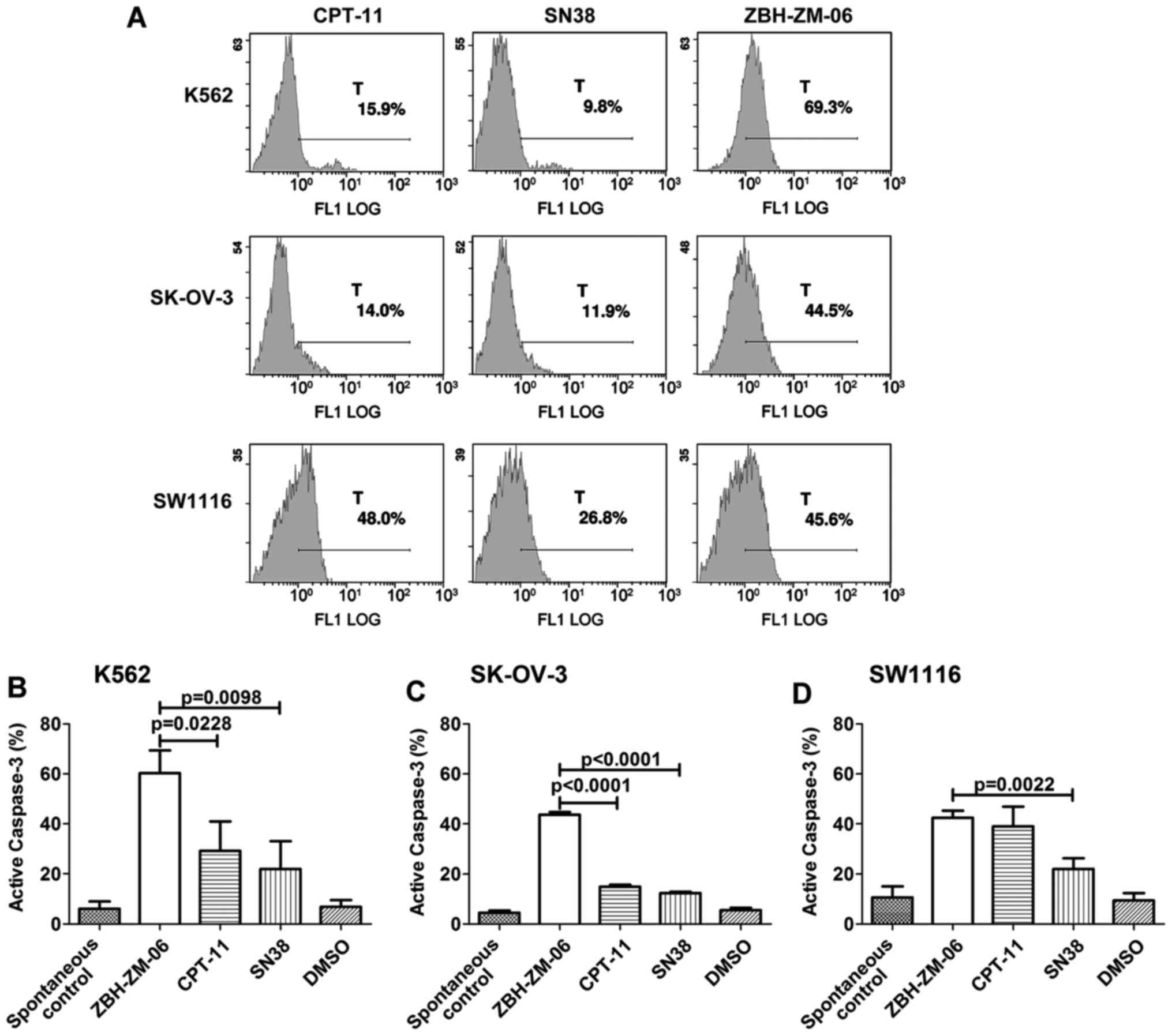|
1
|
Wall ME, Wani MC, Cook CE, Palmer KH,
McPhail AT and Sim GA: Plant antitumor agents. I. The isolation and
structure of camptothecin, a novel alkaloidal leukemia and tumor
inhibitor from camptotheca acuminata1,2. J Am Chem Soc.
88:3888–3890. 1966. View Article : Google Scholar
|
|
2
|
Lin RW, Yang CN, Ku S, Ho CJ, Huang SB,
Yang MC, Chang HW, Lin CM, Hwang J, Chen YL, et al: CFS-1686 causes
cell cycle arrest at intra-S phase by interference of interaction
of topoisomerase 1 with DNA. PLoS One. 9:e1138322014. View Article : Google Scholar : PubMed/NCBI
|
|
3
|
Tomicic MT and Kaina B: Topoisomerase
degradation, DSB repair, p53 and IAPs in cancer cell resistance to
camptothecin-like topoisomerase I inhibitors. Biochim Biophys Acta.
1835:11–27. 2013.PubMed/NCBI
|
|
4
|
Joerger M, Hess D, Delmonte A, Gallerani
E, Fasolo A, Gianni L, Cresta S, Barbieri P, Pace S and Sessa C:
Integrative population pharmacokinetic and pharmacodynamic dose
finding approach of the new camptothecin compound namitecan
(ST1968). Br J Clin Pharmacol. 80:128–138. 2015. View Article : Google Scholar : PubMed/NCBI
|
|
5
|
Joerger M, Hess D, Delmonte A, Gallerani
E, Barbieri P, Pace S and Sessa C: Phase-I dose finding and
pharmacokinetic study of the novel hydrophilic camptothecin ST-1968
(namitecan) in patients with solid tumors. Invest New Drugs.
33:472–479. 2015. View Article : Google Scholar : PubMed/NCBI
|
|
6
|
Naumczuk B, Kawęcki R, Bocian W, Bednarek
E, Sitkowski J and Kozerski L: Preliminary study of mechanism of
action of SN38 derivatives. Physicochemical data, evidence of
interaction and alkylation of DNA octamer d(GCGATCGC)2. Magn Reson
Chem. 55:128–136. 2017. View
Article : Google Scholar : PubMed/NCBI
|
|
7
|
Hamilton G, Klameth L, Rath B and
Thalhammer T: Synergism of cyclin-dependent kinase inhibitors with
camptothecin derivatives in small cell lung cancer cell lines.
Molecules. 19:2077–2088. 2014. View Article : Google Scholar : PubMed/NCBI
|
|
8
|
Vladu B, Woynarowski JM, Manikumar G, Wani
MC, Wall ME, Von Hoff DD and Wadkins RM: 7- and 10-substituted
campto-thecins: Dependence of topoisomerase I-DNA cleavable complex
formation and stability on the 7- and 10-substituents. Mol
Pharmacol. 57:243–251. 2000.PubMed/NCBI
|
|
9
|
Chazin EL, Reis RR, Junior WT, Moor LF and
Vasconcelos TR: An overview on the development of new potentially
active camptothecin analogs against cancer. Mini Rev Med Chem.
14:953–962. 2014. View Article : Google Scholar : PubMed/NCBI
|
|
10
|
Zubovych IO, Sethi A, Kulkarni A, Tagal V
and Roth MG: A novel inhibitor of topoisomerase I is selectively
toxic for a subset of non-small cell lung cancer cell lines. Mol
Cancer Ther. 15:23–36. 2016. View Article : Google Scholar : PubMed/NCBI
|
|
11
|
Liu YP, Chen HL, Tzeng CC, Lu PJ, Lo CW,
Lee YC, Tseng CH, Chen YL and Yang CN: TCH-1030 targeting on
topoisomerase I induces S-phase arrest, DNA fragmentation, and cell
death of breast cancer cells. Breast Cancer Res Treat. 138:383–393.
2013. View Article : Google Scholar : PubMed/NCBI
|
|
12
|
Jeansonne DP, Koh GY, Zhang F,
Kirk-Ballard H, Wolff L, Liu D, Eilertsen K and Liu Z:
Paclitaxel-induced apoptosis is blocked by camptothecin in human
breast and pancreatic cancer cells. Oncol Rep. 25:1473–1480.
2011.PubMed/NCBI
|
|
13
|
Numbenjapon T, Wang J, Colcher D, Schluep
T, Davis ME, Duringer J, Kretzner L, Yen Y, Forman SJ and
Raubitschek A: Preclinical results of camptothecin-polymer
conjugate (IT-101) in multiple human lymphoma xenograft models.
Clin Cancer Res. 15:4365–4373. 2009. View Article : Google Scholar : PubMed/NCBI
|
|
14
|
Morandi E, Severini C, Quercioli D, DArio
G, Perdichizzi S, Capri M, Farruggia G, Mascolo MG, Horn W, Vaccari
M, et al: Gene expression time-series analysis of camptothecin
effects in U87-MG and DBTRG-05 glioblastoma cell lines. Mol Cancer.
7:662008. View Article : Google Scholar : PubMed/NCBI
|
|
15
|
Chen YL, Chueh FS, Yang JS, Hsueh SC, Lu
CC, Chiang JH, Lee CS, Lu HF and Chung JG: Antitumor effects with
apoptotic death in human promyelocytic leukemia HL-60 cells and
suppression of leukemia xenograft tumor growth by irinotecan HCl.
Environ Toxicol. 30:803–815. 2015. View Article : Google Scholar : PubMed/NCBI
|
|
16
|
Yao Y, Su X, Xie Y, Wang Y, Kang T, Gou L,
Yi C and Yang J: Synthesis, characterization, and antitumor
evaluation of the albumin-SN38 conjugate. Anticancer Drugs.
24:270–277. 2013. View Article : Google Scholar : PubMed/NCBI
|
|
17
|
Meco D, Di Francesco AM, Cusano G, Bucci
F, Pierri F, Patriarca V, Torella AR, Pisano C and Riccardi R:
Preclinical evaluation of the novel 7-substituted camptothecin
Namitecan (ST1968) in paediatric tumour models. Cancer Chemother
Pharmacol. 70:811–822. 2012. View Article : Google Scholar : PubMed/NCBI
|
|
18
|
Yu LM, Zhang XR, Li XB, Yang Y, Wei HY, He
XX, Gu LQ, Huang ZS, Pommier Y and An LK: Synthesis and biological
evaluation of 6-substituted indolizinoquinolinediones as catalytic
DNA topoisomerase I inhibitors. Eur J Med Chem. 101:525–533. 2015.
View Article : Google Scholar : PubMed/NCBI
|
|
19
|
Fukuda Y, Kanbe M, Watanabe M, Dan K,
Matsuzaki K, Kitanaka S and Miyata S: 3EZ,20Ac-ingenol, a catalytic
inhibitor of topoisomerases, downregulates p-Akt and induces DSBs
and apoptosis of DT40 cells. Arch Pharm Res. 36:1029–1038. 2013.
View Article : Google Scholar : PubMed/NCBI
|
|
20
|
Zhou M, Liu M, He X, Yu H, Wu D, Yao Y,
Fan S, Zhang P, Shi W and Zhong B: Synthesis and biological
evaluation of novel 10-substituted-7-ethyl-10-hydroxycamptothecin
(SN-38) prodrugs. Molecules. 19:19718–19731. 2014. View Article : Google Scholar : PubMed/NCBI
|
|
21
|
Wu D, Shi W, Zhao J, Wei Z, Chen Z, Zhao
D, Lan S, Tai J, Zhong B and Yu H: Assessment of the
chemotherapeutic potential of a new camptothecin derivative,
ZBH-1205. Arch Biochem Biophys. 604:74–85. 2016. View Article : Google Scholar : PubMed/NCBI
|
|
22
|
Shoemaker RH: The NCI60 human tumour cell
line anticancer drug screen. Nat Rev Cancer. 6:813–823. 2006.
View Article : Google Scholar : PubMed/NCBI
|
|
23
|
Rivory LP, Bowles MR, Robert J and Pond
SM: Conversion of irinotecan (CPT-11) to its active metabolite,
7-ethyl-10-hydroxycamptothecin (SN-38), by human liver
carboxylesterase. Biochem Pharmacol. 52:1103–1111. 1996. View Article : Google Scholar : PubMed/NCBI
|
|
24
|
Senter PD, Beam KS, Mixan B and Wahl AF:
Identification and activities of human carboxylesterases for the
activation of CPT-11, a clinically approved anticancer drug.
Bioconjug Chem. 12:1074–1080. 2001. View Article : Google Scholar : PubMed/NCBI
|
|
25
|
Atyabi F, Farkhondehfai A, Esmaeili F and
Dinarvand R: Preparation of pegylated nano-liposomal formulation
containing SN-38: In vitro characterization and in vivo
biodistribution in mice. Acta Pharm. 59:133–144. 2009. View Article : Google Scholar : PubMed/NCBI
|
|
26
|
Lansiaux A, Léonce S, Kraus-Berthier L,
Bal-Mahieu C, Mazinghien R, Didier S, David-Cordonnier MH,
Hautefaye P, Lavielle G, Bailly C, et al: Novel stable camptothecin
derivatives replacing the E-ring lactone by a ketone function are
potent inhibitors of topoisomerase I and promising antitumor drugs.
Mol Pharmacol. 72:311–319. 2007. View Article : Google Scholar : PubMed/NCBI
|
|
27
|
Liu H, Lu H, Liao L, Zhang X, Gong T and
Zhang Z: Lipid nanoparticles loaded with
7-ethyl-10-hydroxycamptothecin-phospholipid complex: In vitro and
in vivo studies. Drug Deliv. 22:701–709. 2015. View Article : Google Scholar : PubMed/NCBI
|
|
28
|
Zhou S, Li N, Wang X, Li C, Tian F, Ren S,
Zhang Y, He Y, Qiu Z, Zhao D, et al: In vitro cytotoxicity,
pharmacokinetics and tissue distribution in rats of MXN-004, a
novel conjugate of polyethylene glycol and SN38. Xenobiotica.
44:562–569. 2014. View Article : Google Scholar : PubMed/NCBI
|
|
29
|
Demarquay D, Huchet M, Coulomb H,
Lesueur-Ginot L, Lavergne O, Camara J, Kasprzyk PG, Prévost G and
Bigg DC: BN80927: A novel homocamptothecin that inhibits
proliferation of human tumor cells in vitro and in vivo. Cancer
Res. 64:4942–4949. 2004. View Article : Google Scholar : PubMed/NCBI
|
|
30
|
Hyatt JL, Tsurkan L, Morton CL, Yoon KJ,
Harel M, Brumshtein B, Silman I, Sussman JL, Wadkins RM and Potter
PM: Inhibition of acetylcholinesterase by the anticancer prodrug
CPT-11. Chem Biol Interact 157–158. 1–252. 2005.
|
|
31
|
Dodds HM, Hanrahan J and Rivory LR: The
inhibition of acetylcholinesterase by irinotecan and related
camptothecins: Key structural properties and experimental
variables. Anticancer Drug Des. 16:239–246. 2001.PubMed/NCBI
|
|
32
|
Patnaik A, Papadopoulos KP, Tolcher AW,
Beeram M, Urien S, Schaaf LJ, Tahiri S, Bekaii-Saab T, Lokiec FM,
Rezaï K, et al: Phase I dose-escalation study of EZN-2208
(PEG-SN38), a novel conjugate of poly(ethylene) glycol and SN38,
administered weekly in patients with advanced cancer. Cancer
Chemother Pharmacol. 71:1499–1506. 2013. View Article : Google Scholar : PubMed/NCBI
|
|
33
|
Wadkins RM, Bearss D, Manikumar G, Wani
MC, Wall ME and Von Hoff DD: Topoisomerase I-DNA complex stability
induced by camptothecins and its role in drug activity. Curr Med
Chem Anticancer Agents. 4:327–334. 2004. View Article : Google Scholar : PubMed/NCBI
|
|
34
|
Motwani M, Sirotnak FM, She Y, Commes T
and Schwartz GK: Drg1, a novel target for modulating sensitivity to
CPT-11 in colon cancer cells. Cancer Res. 62:3950–3955.
2002.PubMed/NCBI
|
|
35
|
Liu YQ, Li WQ, Morris-Natschke SL, Qian K,
Yang L, Zhu GX, Wu XB, Chen AL, Zhang SY, Nan X, et al:
Perspectives on biologically active camptothecin derivatives. Med
Res Rev. 35:753–789. 2015. View Article : Google Scholar : PubMed/NCBI
|
|
36
|
Li J, Ouyang Y, Zhang X, Zhou W, Wang F,
Huang Z, Wang X, Chen Y, Zhang H and Fu L: Effect of HM910, a novel
camptothecin derivative, on the inhibition of multiple myeloma cell
growth in vitro and in vivo. Am J Cancer Res. 5:1000–1016.
2015.PubMed/NCBI
|
|
37
|
Ohmori T, Podack ER, Nishio K, Takahashi
M, Miyahara Y, Takeda Y, Kubota N, Funayama Y, Ogasawara H, Ohira
T, et al: Apoptosis of lung cancer cells caused by some anti-cancer
agents (MMC, CPT-11, ADM) is inhibited by bcl-2. Biochem Biophys
Res Commun. 192:30–36. 1993. View Article : Google Scholar : PubMed/NCBI
|
|
38
|
Zuco V, De Cesare M, Zaffaroni N, Lanzi C
and Cassinelli G: PLK1 is a critical determinant of tumor cell
sensitivity to CPT11 and its inhibition enhances the drug antitumor
efficacy in squamous cell carcinoma models sensitive and resistant
to camptothecins. Oncotarget. 6:8736–8749. 2015. View Article : Google Scholar : PubMed/NCBI
|
|
39
|
Cao Y, Jin ZX, Tong XP, Yue S, Sakai T,
Kawanami T, Sawaki T, Miki M, Iwao H, Nakajima A, et al:
Synergistic effects of topoisomerase I inhibitor, SN38, on
Fas-mediated apoptosis. Anticancer Res. 30:3911–3917.
2010.PubMed/NCBI
|
|
40
|
Di Francesco AM, Riccardi A, Barone G,
Rutella S, Meco D, Frapolli R, Zucchetti M, DIncalci M, Pisano C,
Carminati P, et al: The novel lipophilic camptothecin analogue
gimatecan is very active in vitro in human neuroblastoma: A
comparative study with SN38 and topotecan. Biochem Pharmacol.
70:1125–1136. 2005. View Article : Google Scholar : PubMed/NCBI
|

















